May 28, 2025 | 11:00 GMT +7
May 28, 2025 | 11:00 GMT +7
Hotline: 0913.378.918
May 28, 2025 | 11:00 GMT +7
Hotline: 0913.378.918

Latex production at Viet Lao Rubber Company Limited - the unit used biomass fuel instead of DO to steam-dry rubber. Photo: Thanh Son.
The rubber latex processing factory of Chu Se - Kampong Thom Rubber Joint Stock Company (Kampong Thom province, Cambodia) is a factory with considerable capacity in the Vietnamese rubber industry, with a capacity of 32,400 tons/year.
Previously, the factory-powered furnace was heated with diesel fuel. But in the past 2 years, the factory has converted to biomass fuel. Taking us to visit the furnace heat supply system, Mr. Nguyen Duy Linh, General Director of Chu Se Rubber - Kampong Thom, shared that, due to the high price of diesel oil (DO) in recent years, the company has invested in a furnace heat supply system using rice husks. The rice husk source is purchased by Chu Se-Kampong Thom Rubber from rice mills around the project, mainly from factories that have contracts to supply rice to the company's workers.
Switching from diesel to using rice husks to dry rubber latex has helped Chu Se-Kampong Thom Rubber save huge costs, reducing total fuel costs by 20 - 25%. Furthermore, the method of steaming and drying with rice husks also increases the quality of the company's rubber products.
Many member companies of the Vietnam Rubber Industry Group (VRG) at home and abroad have also been converting their energy use from diesel to biomass. This helped them in reducing energy costs. Mr. Pham Van Thong, Deputy General Director of Viet Lao Rubber Company Limited (Chamasak province, Laos), said, the company has a rubber latex processing factory with a total capacity of 21,000 tons/year. At this factory, the company has invested in a biomass heat supply system to replace the use of diesel.

The conveyor belt brings rice husks into the heating furnace at Chu Se Rubber - Kampong Thom factory. Photo: Thanh Son.
According to Mr. Do Minh Tuan, General Director of Dong Nai Rubber Corporation (Donaruco), in recent years, Donaruco has applied the conversion of DO oil/gas fuel to dry latex to biomass fuel and used solar energy instead of electricity. The company aims to meet the production process according to VRG's sustainable development orientation.
Previously, all of VRG's rubber processing factories used a drying system with a DO oil combustion chamber with gas and firewood, through a fan system that directly distributes hot air throughout the rubber drying chamber.
Dried latex products, especially granulated latex, have high-quality requirements while drying systems using oil combustion chambers sometimes contaminate drying products with the smell of oil or gas due to incompletely burned fuel sticking to the product. Besides, using oil for drying makes fuel consumption costs high and unstable. Specifically, with rubber types such as SVR 3L, CV50, and CV60, each ton of product uses up to 26 - 30 litres of DO oil. As for product types such as SVR10, and 20, each ton of product consumes 34 - 38 liters of DO oil.
Faced with that situation, in recent years, VRG has encouraged units to convert fuel from DO oil, gas and other fuels to biomass fuel for environmental protection. The switch to using biomass also aims to reduce emissions, reduce processing costs, reduce costs and is consistent with the Group's sustainable development orientation.

Rice husk warehouse for fuel at Chu Se Rubber factory - Kampong Thom. Photo: Thanh Son.
Currently, factories are using biomass fuel in circulating fluidized bed boiler technology. A circulating fluidized bed boiler is a type of steam-generating equipment using fluidized bed combustion chamber technology combined with heat recovery and recirculation technology along with several other auxiliary devices. This creates a complete device capable of effectively converting the chemical energy contained in solid fuels (crushed rice husks, sawdust, shavings, indo coal...) into steam energy to supply the rubber latex drying kiln.
The drying air temperature is controlled by a control valve. If the air temperature is lower than the required temperature, the control valve will automatically adjust the amount of hot medium entering the heat exchange system, in the opposite case, the system will automatically adjust downward. Therefore, the air temperature in the drying tunnel is maintained very stable.
The use of biomass heating instead of DO oil at rubber processing factories in recent times has brought positive results. Regarding product quality, dried rubber latex has a brighter and more beautiful colour, does not darken due to oil soot, and does not appear with a smoky pattern.
During the process of drying latex with biomass heat, the factory is not pressured by the problem of fuel consumption, so the drying time is long and the temperature is low. Thanks to that, the Po and PRI indexes are higher than when drying latex with DO oil, and the Po index fluctuates less within a batch.
After being dried with biomass, rubber latex does not absorb surface heat, has good porosity, and has good evaporation. Therefore, the latex ripens evenly, there is no more darkening at the bottom of the blister, and the colour of the latex is more uniform and brighter. Combined with the classification of latex materials, SVR L latex can be processed, thereby increasing the value of the product. Drying latex with biomass also helps make the latex more porous. After drying, the latex dissipates heat well below 40 degrees Celcius, so the process of storing latex in iron pallets does not discolour the lower 3 layers and the colour is uniform in one package.
In addition to economic efficiency, there are environmental benefits. Drying latex with biomass heat, drying oven and blister tank is cleaner than drying with DO oil. Therefore, the frequency of cleaning the blister tank is reduced to 2.5 months/time compared to 1.5 months/time because there is no smoke from directly burning DO oil.
Translated by Hoang Duy
/2025/05/25/4127-3-073637_820.jpg)
(VAN) Thanks to the promotion from an FAO-implemented project, vegetable production in greenhouses in Moc Chau has seen strong development, from 1.5 hectares in 2021 to nearly 50 hectares in 2024.

(VAN) FAO has recently supported USD 140,000 to implement the project 'Risk mitigation human-animal interface risks through disease control initiatives in pig farming.'

(VAN) The People's Committee of Tra Vinh province has approved an adjustment to the investment policy for the Green Hydrogen Plant project, increasing its area to approximately 52.76 hectares.
![Reducing emissions from rice fields: [2] Farmers’ commitment to the soil](https://t.ex-cdn.com/nongnghiepmoitruong.vn/608w/files/news/2025/05/05/dsc08881jpg-nongnghiep-140632.jpg)
(VAN) Clean rice cultivation model in Thuong Tan commune, Bac Tan Uyen district, is assisting local residents in achieving sustainable agriculture by substantially reducing costs, increasing productivity, and protecting the environment.

(VAN) At the conference to disseminate Resolution No. 68, AgriS introduced its digital agricultural ecosystem and reaffirmed its commitment to accompanying the Government in promoting private sector development and sustainable agriculture.

(VAN) 'Blue Ocean - Blue Foods' initiative is designed to restore marine ecosystems and establish sustainable livelihoods for local communities by cultivating a minimum of 1,000 hectares of cottonii seaweed in the first three years.
/2025/05/21/4642-3-112707_603.jpg)
(VAN) The V-SCOPE project has made direct contributions to three out of six pillars of the Comprehensive Strategic Partnership between Vietnam and Australia.